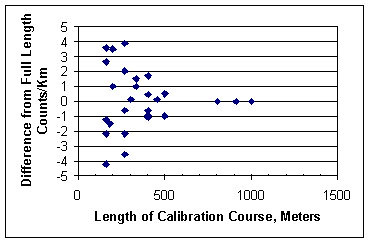Older measurers will remember the 1970’s and early 1980’s when the minimum length of a calibration course was either a kilometer or ½ mile. As this is a daunting length to lay out, few calibration courses existed. People would drive many miles to and from a calibration course, if they could not find one close to the race course.
In October 1985, in Measurement News #13 I asked people to help with an experiment. The purpose of the experiment was to get a handle on the magnitude of “startup wobble” which was thought to affect calibration. Wayne Nicoll, Pete Riegel, Tom McBrayer, Bob Baumel, David Reik, Tom Knight, Kevin Lucas and Paul Christensen responded with data.
Each person was asked to make 5 rides of a calibration course, as follows:
First ride – no stops
Second Ride – 1 intermediate stop
Third Ride – 3 intermediate Stops
Fourth Ride – 5 intermediate stops
Fifth Ride – no stops.
They were asked to do this twice. Counts were recorded only on completion of the full ride. No intermediate counts were recorded.
Results were published in February 1986 Measurement News #15 and are seen below.

To my surprise, the effect of startup wobble was not one-sided. Instead, as calibration length got shorter, scatter increased in both directions. After some discussion among participants and RRTC people, 300 meters or 1000 feet was taken as the new minimum length for a US calibration course.
Original data is in an Excel file. Anyone who wants to try his hand at analysis need only ask me.
I don't think shortening the minimum even further is a good idea.
